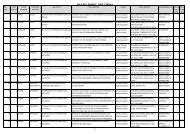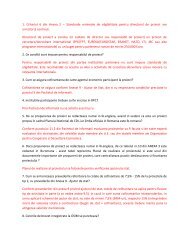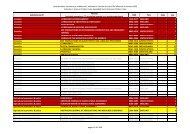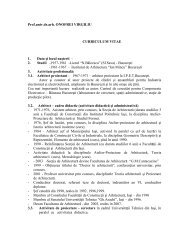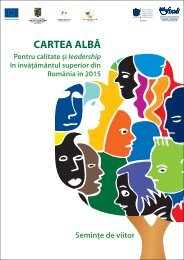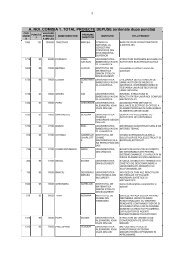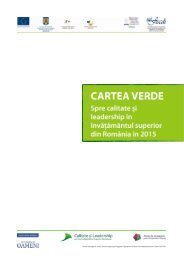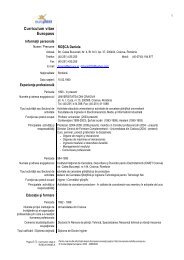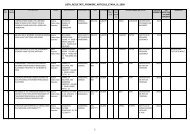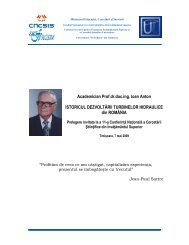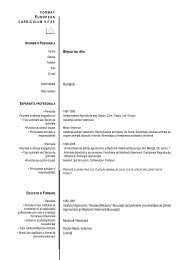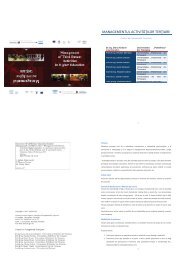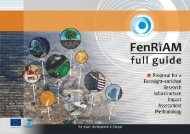Povesti de succes - uefiscdi
Povesti de succes - uefiscdi
Povesti de succes - uefiscdi
Create successful ePaper yourself
Turn your PDF publications into a flip-book with our unique Google optimized e-Paper software.
Ecologie Sistemică, Eco-diversitate şi Sustenabilitatea Dezvoltării<br />
44<br />
În ceea ce priveşte infrastructura fizică <strong>de</strong> cercetare,<br />
aceasta s-a <strong>de</strong>zvoltat şi mo<strong>de</strong>rnizat prin: i) achiziţionarea<br />
laboratoarelor mobile (nava laborator „Universitatea 2” şi<br />
auto-laborator), crearea laboratoarelor <strong>de</strong> la staţiunile <strong>de</strong><br />
cercetare – Brăila şi Sinaia şi a laboratoarelor şi Bazei <strong>de</strong><br />
Cercetări cu Utilizări Multiple (BCUM) în clădirea Facultăţii<br />
<strong>de</strong> Biologie; ii) reînoirea şi extin<strong>de</strong>rea echipamentelor<br />
pentru măsurători în teren a parametrilor cheie a unităţilor<br />
hidro-morfologice şi climei, pentru prelevarea probelor ecologice<br />
şi analiza acestora şi pentru susţinerea experimentelor<br />
în situ şi în laborator şi iii) crearea şi completarea unor configuraţii<br />
complexe şi performante pentru analize şi <strong>de</strong>ter-<br />
minări speciale (eg. extracţie şi măsurare a conţinutului în<br />
metale grele, măsurarea conţinutului <strong>de</strong> C, N, P, S a probelor<br />
biologice, măsurarea şi estimarea cantităţii <strong>de</strong> ATP şi a biomasei<br />
fito şi bacterioplanctonului, măsurarea valorii energetice<br />
şi estimarea bugetului energetic); iv) sisteme <strong>de</strong><br />
analiză şi i<strong>de</strong>ntificare a compoziţiei taxonomice; v) configuraţie<br />
pentru analiza GIS şi vi) componente soft pentru<br />
procesarea datelor empirice şi mo<strong>de</strong>lare numerică.<br />
Resursa umană implicată<br />
Structura <strong>de</strong> personal a CCESES/DESS-UniBuc a fost<br />
şi este flexibilă pentru a răspun<strong>de</strong> rapid şi eficient, pe <strong>de</strong> o<br />
parte, cerinţelor <strong>de</strong> a aborda probleme <strong>de</strong> cercetare fundamentală<br />
şi aplicată privind complexitatea relaţiilor spaţiotemporale<br />
dintre componentele diversităţii biologice şi<br />
ecologice şi dintre acestea şi componentele sistemelor socioeconomice<br />
sau sistemului climatic (CN↔SSE) iar, pe <strong>de</strong><br />
altă parte, <strong>de</strong> a se constitui într-un nucleu multidisciplinar<br />
capabil să <strong>de</strong>zvolte şi să aplice mo<strong>de</strong>le conceptuale şi<br />
analitice bazate pe elementele fundamentale ale teoriei ecosistemice<br />
a sustenabilităţii, respectiv, să catalizeze formarea<br />
reţelelor naţionale <strong>de</strong> experţi în domeniu sau să se integreze<br />
în reţele internaţionale. În plus flexibilitatea structurii <strong>de</strong><br />
personal trebuia să permită adaptarea acesteia la dinamica<br />
cerinţelor <strong>de</strong> <strong>de</strong>zvoltare şi aplicare a cunoaşterii sau a oportunităţilor<br />
<strong>de</strong> finanţare şi nu în ultimul rând să asigure integrarea<br />
eficientă a expertizei şi potenţialului <strong>de</strong> cercetare a<br />
personalului didactic şi stu<strong>de</strong>nţilor implicaţi în programele<br />
<strong>de</strong> masterat şi doctorat. Din această perspectivă schema <strong>de</strong><br />
personal a CCESES a inclus: i) poziţii <strong>de</strong> cercetare permanente<br />
ocupate integral <strong>de</strong> către 3 CS I şi 4 CS III; ii) 4 poziţii<br />
permanente (CS I şi CS II) ocupate prin cumul <strong>de</strong> către<br />
3-5 profesori şi/sau 2-3 conferenţiari; iii) 4 poziţii tempo-<br />
bined with extensive cooperation and networking for building<br />
critical capacity required by the ecosystem approach of the<br />
dynamics of structural and functional complexity of ecosystems,<br />
landscapes and SECS, has been one of the major<br />
strategic targets of CSEES/UniBuc. Since 1990, when new<br />
circumstances allowed contacts and scientific cooperation<br />
with partners located abroad, the research infrastructure and<br />
scientific expertise in the field of ecosystem theory and hierarchical<br />
organization of nature/environment of the CSEES/<br />
UniBuc, were in an advanced phase of <strong>de</strong>velopment.<br />
That allowed quick integration of CSEES/UniBuc in<br />
pan-European consortia of universitary research centers and<br />
institutes, national research institutes, institutes of the national<br />
Aca<strong>de</strong>mies and EU research institutes.<br />
In almost 16 years has been established scientific cooperation<br />
with more than 70 research organization distributed<br />
around EU – 27 and USA, Canada, Norway, Switzerland, Israel,<br />
Russia, Turkey, Azerbaijan, Kyrgyz Republic, Morocco,<br />
Algeria.<br />
Such extensive cooperation was financially supported<br />
by: i) EU research frame programme (FP4, FP5, FP6, FP7)<br />
funds, for 15 projects of different types (more than 2.2 million<br />
ECU and Euro input at CSEES/UniBuc); ii) NATO-<br />
CCMS for 3 <strong>succes</strong>sive projects <strong>de</strong>aling with “Ecosystem<br />
Mo<strong>de</strong>lling for Integrated Management of the Lagoon Systems<br />
and Coastal Socio-Ecological Complexes”, and iii) National<br />
Science Foundation/USA.<br />
Since 2002, as partner in the Global Network for Long<br />
Term Ecosystem Research (ILTER) we are involved, with<br />
Lower Danube River Wetlands System (DRWS) case study,<br />
in the assessment of functions and services of the components<br />
of Earth’s natural capital. This is a significant contribution<br />
to un<strong>de</strong>rstanding carrying capacity and vulnerabilities<br />
of the Ecosphere and an opportunity to increase the visibility<br />
of CSEES/UniBuc.



